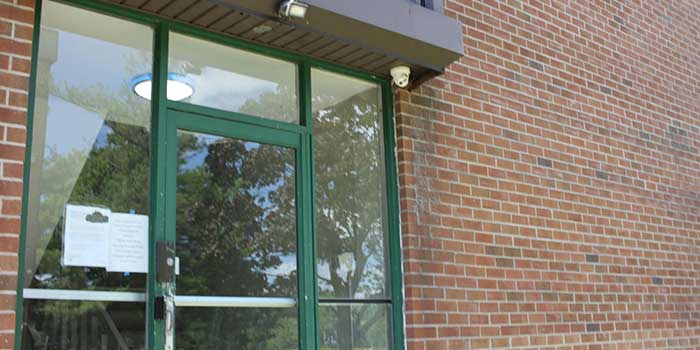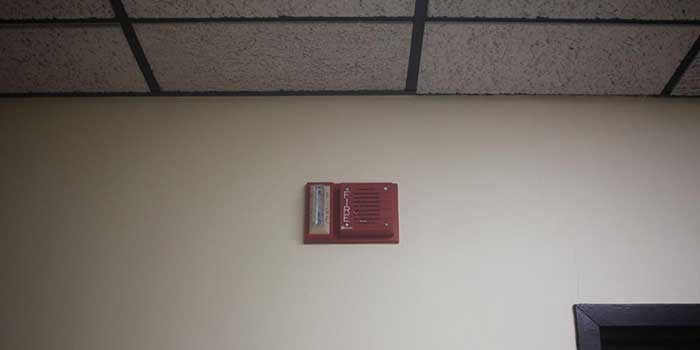Video MGMT System
 Access Control
Access Control
Voice & Data Wiring
 Burglar Alarm
Burglar Alarm
 Fire Alarm
Fire Alarm
Video MGMT System
Voice & Data Wiring
THOUGHT CENTER > Blog > Security Systems
August 29, 2023
Too busy to read? Here’s a summary:
Property owners and managers today are increasingly integrating their security systems, including those for fire, burglary, surveillance, and access control. Keep on reading to find out why so many businesses and institutions are taking this step.

Security system integration is the process of combining security devices for surveillance, threat detection, and access control into a single, interconnected system.
This unification facilitates data sharing among the systems to enhance reliability, minimize false alarms, and enable emergency protocol automation.
Before you start integrating your security systems, there are a few requirements your system needs to meet:
Your security devices need to be IP-based. This means they must be able to connect to the Internet.
Not all security systems are compatible with each other, but most brands that operate on open-source software can be integrated. Avigilon, Honeywell, and Axis stand out for the open-source security products that they manufacture.
You can make sure the systems you want to integrate are compatible by researching spec sheets, contacting manufacturers, or reaching out to expert integrated security system installers.

ONVIF (Open Network Video Interface Forum) is a global standard that ensures IP security cameras can work together within a single camera system or as part of an integrated system.
Hardwire your security systems with low-voltage structured cabling for the most reliable security.
Wireless systems are no more reliable than their Wi-Fi connection.

There are many benefits to having an integrated fire alarm system. For example, in the event of a fire, an integrated fire alarm system can automatically unlock doors (for safe evacuation) and notify the fire department.
When your burglary alarm system is integrated with other security systems, such as those for surveillance and access control, the overall system becomes dramatically more effective.
For example, if an alarm is triggered, integrated surveillance cameras can automatically focus on the area of concern and provide real-time visual confirmation of the situation.
An integrated system can even be configured to alert necessary authorities in the event of a break-in immediately. This rapid response minimizes property damage and increases the likelihood that intruders will be apprehended and property will be recovered.
Integrated access control systems share their data and collect data from other security system components for maximum access control effectiveness.
For instance, if an unauthorized access attempt is made, an integrated access control system can automatically trigger an alarm and direct cameras to the location for real-time visual confirmation.
Video surveillance systems are a deterrent to potential intruders and provide valuable evidence in case of an incident, but integrated camera systems provide the greatest security.
For example, if an alarm is triggered or an unauthorized access attempt is made, an integrated security system can automatically direct cameras to the location. The result? Real-time visual confirmation of the situation, as well as high-definition or high-resolution evidence collection.

By linking systems for video surveillance, access control, and threat detection, you can ensure that all areas of your property are monitored and protected.
In the event of a security incident, an integrated system can trigger an immediate response. For instance, if a fire alarm is triggered, the system can automatically unlock doors for a quicker evacuation. And if a burglary alarm is activated, the system can immediately alert authorities.
An integrated system can streamline operations by allowing you to manage all aspects of your security infrastructure from a single point of control. This saves time and reduces the risk of errors that occur when managing the systems separately.
An integrated system can provide comprehensive reports on any incidents, including when an alarm is triggered, the response taken, and the outcome. This can be helpful for reviewing safety procedures and making necessary improvements.
By integrating your fire alarm with other systems, you can reduce the costs associated with managing multiple, separate security systems.
This can also lead to savings in energy costs, as integrated systems often allow for more efficient use of resources.
Integrated security systems are typically easier to scale as your needs change. You can add new components or upgrade existing ones without having to overhaul the entire system.
With an integrated system, you can utilize a remote monitoring service for 24/7 video monitoring. This allows for immediate action when security incidents occur.
24/7 monitoring services are so effective at catching incidents early and reducing losses that many home insurers reserve their largest discounts for policyholders who install advanced alarm systems connected with a remote monitoring service.
Integrating your security system is a smart choice. It enhances your security, makes management easier, and even saves money in the long run.
Our team of experts at Mammoth Security can guide you through the integration process and make sure you have a well-designed, properly configured, and cost-effective security system.
So why wait? Contact Mammoth Security today by filling out the simple blue form below.
NOT COMPLETELY SURE?
860-748-4292Security system integration is the process of combining multiple security applications and devices into a unified system, allowing them to communicate and work together for enhanced security.
The requirements for security system integration include having IP-based devices, open-source systems, and hardwired cabling for reliable data transmission.
The steps to security system integration include assessment of current security measures, planning for integration, implementation, testing of the integrated system, and regular maintenance.
Various types of security systems can be integrated, including alarm systems, access control systems, video surveillance systems, and smart building automation systems.
IP devices, which can connect to the Internet, are crucial for security system integration as they allow different security systems to work together.
Hardwired systems are preferred in security system integration because they offer reliable connections for data transmission and are less prone to interference than wireless systems.
Security system integration saves money in the long run by preventing losses and reducing the costs associated with managing multiple, separate security systems.
Advanced surveillance technologies benefit banks by deterring criminal activities, aiding in customer dispute resolution, and enhancing trust in the institution's commitment to asset protection and on-site security.